Bamboo is one of the most versatile and resilient plants in the world, offering a wide range of species suitable for various landscapes and climates. With its fast growth and distinctive appearance, bamboo has become a popular choice for gardeners, landscapers, and homeowners alike. In this article, we’ll explore 45 types of bamboo plants, highlighting their unique characteristics, growth habits, and ideal growing conditions.
Selecting the right bamboo for your garden or landscape requires a good understanding of the different types of bamboo plants available. From towering giants to compact varieties perfect for small spaces, bamboo provides a solution for virtually any gardening need. If you’re after a privacy screen, ornamental feature, or a low-maintenance addition to your yard, bamboo has something to offer.
This article will equip you with all the knowledge needed to find the perfect bamboo for your garden. Let’s dive in and explore the fascinating world of bamboo!
Different Types of Bamboo Plants
Phyllostachys edulis (Moso Bamboo)
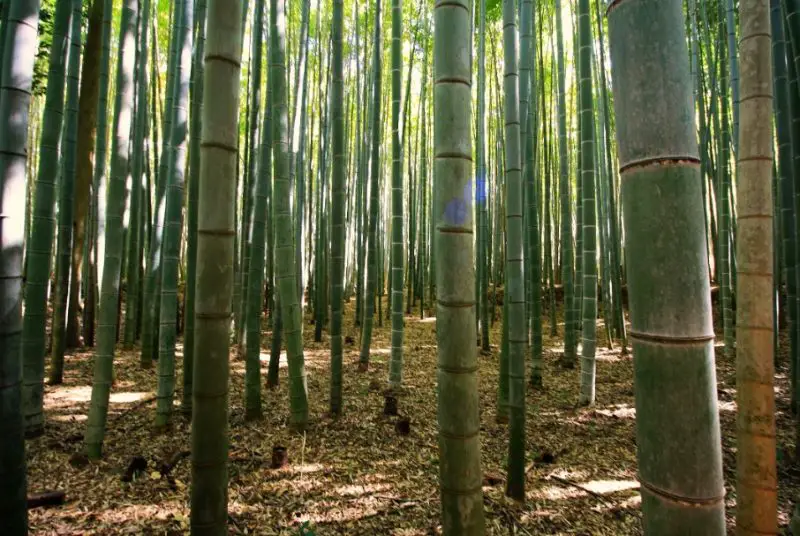
Phyllostachys edulis, commonly known as Moso Bamboo, is one of the largest and most economically significant bamboo species in the world. Native to China and Taiwan, Moso Bamboo features towering culms that are smooth, thick, and green when young, aging to a yellowish-green hue. It typically grows between 50 to 70 feet (15 to 21 meters) tall, with culm diameters reaching up to 7 inches (18 cm). The nodes are slightly swollen and widely spaced, while its small, lance-shaped leaves contrast beautifully with its massive, stately stalks.
Thriving in USDA hardiness zones 7 to 11, Moso Bamboo prefers well-drained, fertile, loamy soils and does best under full sun, although it can tolerate some shade. It requires consistent watering during establishment, but once mature, it becomes relatively drought-tolerant and hardy down to about 5°F (-15°C). Care for Moso Bamboo includes mulching to retain soil moisture, occasional fertilization, and thinning of older canes to encourage healthier growth and improved airflow.
Moso Bamboo is highly valued for its strength and versatility. It is extensively used for flooring, furniture, textiles, paper, and edible bamboo shoots. Its majestic appearance also makes it ideal for creating ornamental groves, windbreaks, and large-scale privacy screens in parks and estates. In China, it holds cultural significance and is considered a symbol of resilience and integrity.
Phyllostachys aurea (Golden Bamboo)
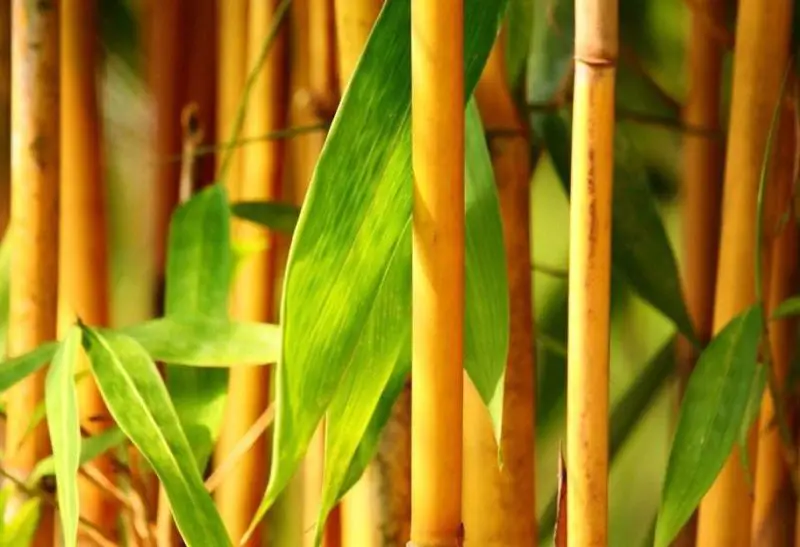
Phyllostachys aurea, also known as Golden Bamboo or Fishpole Bamboo, is a highly adaptable and fast-growing species originating from China. It is renowned for its vibrant golden-yellow culms, which become more intensely colored with sun exposure. Golden Bamboo usually grows to a height of 20 to 30 feet (6 to 9 meters) with culm diameters around 1.5 inches (4 cm). A distinctive feature is the shortened internodes near the base of the culm, giving it a knotted, compact appearance that is easily recognizable.
This bamboo species thrives in USDA zones 6 to 10 and can tolerate a wide range of soil types, although it prefers well-drained, fertile ground. It grows best in full sun but also adapts to partial shade. Golden Bamboo needs regular watering during the initial establishment phase but becomes moderately drought-tolerant afterward. To prevent unwanted spreading, it is advisable to install root barriers or plant it in large containers, especially in suburban landscapes.
Golden Bamboo is a popular choice for creating quick-growing privacy screens, hedges, and windbreaks. Its lightweight yet strong culms are traditionally used for garden structures, fishing poles, and light construction. With its bright, cheerful coloration and dense foliage, it adds a tropical and vibrant aesthetic to gardens, patios, and urban green spaces.
Bambusa vulgaris (Common Bamboo)

Bambusa vulgaris, commonly referred to as Common Bamboo, is one of the most widely cultivated tropical bamboo species. Originating from Southeast Asia, particularly in India and Southern China, it is easily identified by its thick, bright green culms or sometimes yellow culms with green stripes. It typically grows between 35 to 50 feet (10 to 15 meters) tall with culm diameters ranging from 2 to 4 inches (5 to 10 cm). Its open clumping growth habit and prominent nodes make it visually striking in any landscape.
Common Bamboo grows well in USDA zones 9 to 11, preferring warm, humid climates with full sun to partial shade. It thrives in well-drained, slightly acidic to neutral soils and benefits from regular watering, especially during dry periods. Although generally resilient, it should be protected from strong winds, which may damage its tall culms. Care includes occasional thinning of older culms and mulching around the base to conserve moisture.
This bamboo species is extensively used for ornamental purposes, construction, fencing, and erosion control. Its young shoots are edible and harvested in many Asian cuisines. Due to its open growth form and graceful appearance, Bambusa vulgaris is ideal for creating tropical-themed gardens, decorative borders, and serene green backdrops in parks and private landscapes.
Phyllostachys nigra (Black Bamboo)
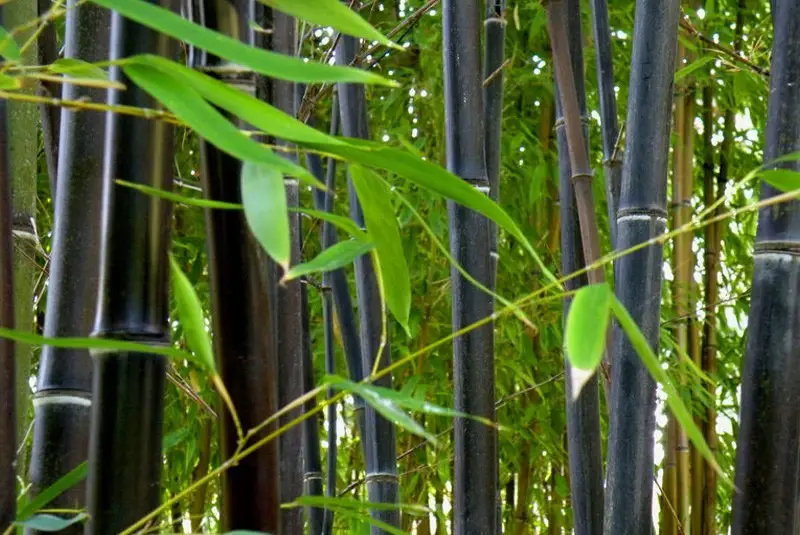
Phyllostachys nigra, commonly known as Black Bamboo, is one of the most visually striking bamboo species due to its dramatic jet-black culms. Native to China, Black Bamboo initially produces green culms that gradually turn a deep black color within the first two to three years. Mature plants typically reach heights of 20 to 35 feet (6 to 10 meters), with culm diameters around 2 inches (5 cm). The contrast between the black culms and lush green foliage creates an elegant, sophisticated look in gardens and landscapes.
This species thrives best in USDA zones 7 to 10, preferring moist, well-drained soils and full sun to partial shade. Black Bamboo requires consistent watering during the establishment phase but becomes relatively hardy and drought-tolerant with age. Pruning old and weak culms annually helps maintain a healthy, attractive clump, and root barriers are recommended to control its running growth habit.
Black Bamboo is widely appreciated for its ornamental value and is often used in landscape designs to create focal points, privacy screens, or elegant natural fences. The dark-colored culms are also sought after for decorative crafts, musical instruments, and fine furniture. Its exotic appearance makes it a favorite among garden designers aiming for a bold, unique statement.
Bambusa oldhamii (Giant Timber Bamboo)
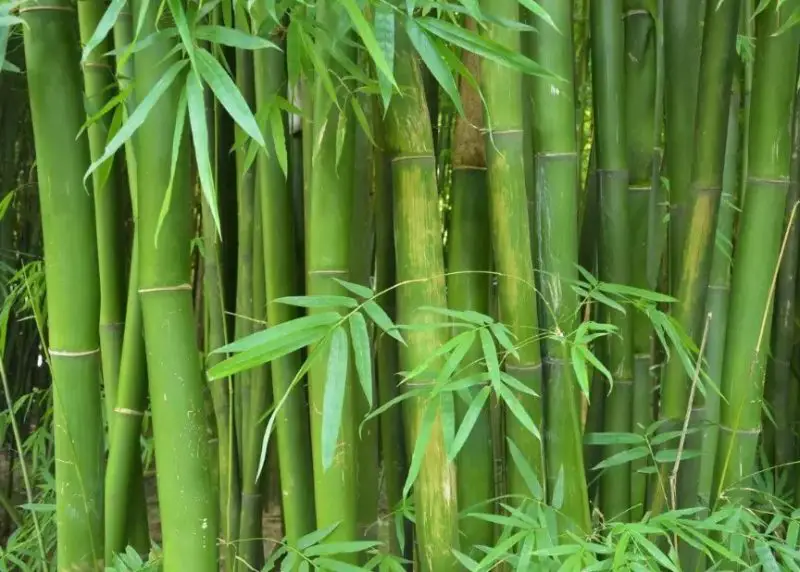
Bambusa oldhamii, known as Giant Timber Bamboo, is a tropical clumping bamboo native to Taiwan. It is celebrated for its tall, upright growth and thick-walled green culms that can reach heights of 40 to 60 feet (12 to 18 meters) with a culm diameter of about 4 inches (10 cm). The culms are glossy, dark green, and spaced relatively closely, giving the plant a tidy, vertical appearance ideal for formal gardens and windbreaks.
Giant Timber Bamboo grows best in USDA zones 8 to 11, favoring full sun and well-drained, fertile soils. It requires regular watering during establishment but is moderately drought-tolerant once mature. Minimal maintenance is needed, apart from occasional removal of old or damaged culms to promote new growth. Its non-invasive clumping habit makes it a practical choice for larger residential and commercial landscapes.
Highly valued for its strong, thick poles, Bambusa oldhamii is widely used in construction, woodworking, and landscaping. Its fast growth and towering size make it perfect for creating tall privacy screens, natural barriers, and impressive ornamental displays. In addition, its edible young shoots are tender and delicious, making it a popular choice for home gardeners and farmers alike.
Fargesia robusta (Robust Bamboo)
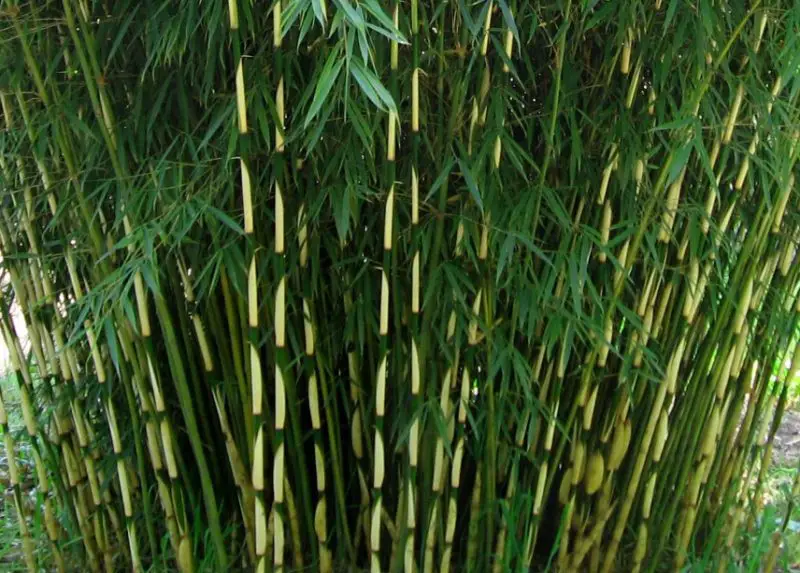
Fargesia robusta, commonly called Robust Bamboo, is a cold-hardy, clumping bamboo native to the mountainous regions of Western China. Known for its neat, upright form and graceful foliage, it typically grows between 10 to 15 feet (3 to 4.5 meters) tall with culm diameters of about 0.75 inches (2 cm). The young culms emerge bright green with striking white sheaths that eventually fall away, giving the plant a clean, polished look.
Robust Bamboo thrives in USDA zones 6 to 9 and prefers cool, moist, well-drained soils. It grows best in part shade but can tolerate full sun in cooler climates. Unlike running bamboo types, Fargesia robusta forms tight, non-invasive clumps that require little maintenance. Regular watering, especially during dry spells, and mulching around the base help maintain healthy growth and rich foliage.
This bamboo is an excellent choice for small gardens, container planting, hedges, and shade gardens. Its dense, upright habit makes it ideal for privacy screens without the worry of aggressive spreading. Thanks to its high cold tolerance and beautiful, tidy appearance, Fargesia robusta is a favorite among gardeners in temperate and mountainous regions seeking a low-maintenance yet elegant bamboo species.
Fargesia murielae (Umbrella Bamboo)
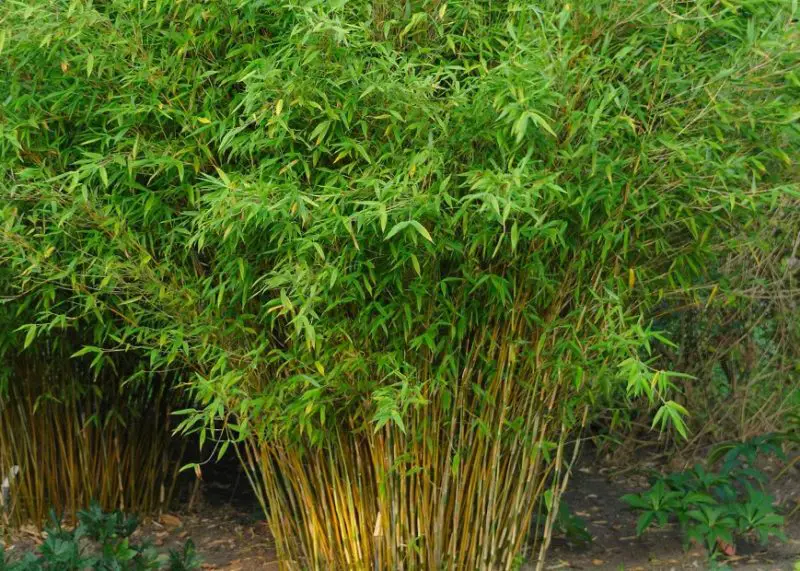
Fargesia murielae, commonly known as Umbrella Bamboo, is a graceful, clumping bamboo native to the mountainous forests of central China. It is easily recognized by its arching canes and fine-textured, lush green foliage, which together create a soft, cascading effect reminiscent of an umbrella. Mature plants typically reach 10 to 15 feet (3 to 4.5 meters) tall with slender culms about 0.5 to 1 inch (1.3 to 2.5 cm) in diameter. The new culms emerge bright green and develop a slightly yellow tint as they age.
Umbrella Bamboo thrives in USDA zones 5 to 9, making it one of the most cold-hardy bamboo species available. It prefers part shade but can tolerate full sun in cooler climates, provided that it receives consistent moisture. This species grows best in fertile, well-drained soils with regular watering during dry spells. Its clumping nature means it will not become invasive, making it perfect for smaller gardens or container planting.
Fargesia murielae is widely used for creating dense, attractive hedges, privacy screens, or adding a soft, elegant touch to shaded woodland gardens. Its ability to tolerate cold winters and its non-invasive growth make it a top choice for gardeners in temperate regions. The plant’s graceful, fountain-like shape adds a soothing, naturalistic element to landscaping designs.
Phyllostachys bambusoides (Japanese Timber Bamboo)
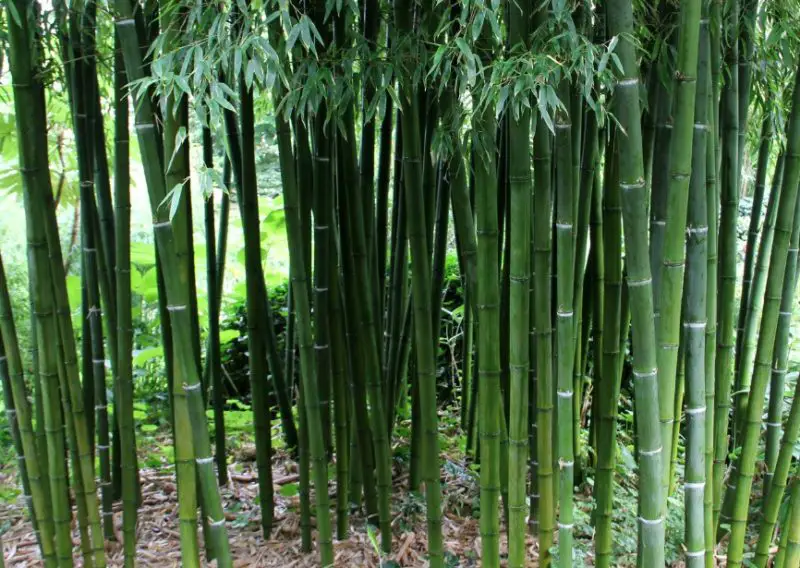
Phyllostachys bambusoides, known as Japanese Timber Bamboo or Madake, is a majestic, running bamboo species native to China and widely cultivated in Japan. It features tall, straight culms that can reach towering heights of 50 to 70 feet (15 to 21 meters) and diameters of up to 6 inches (15 cm). The culms are typically deep green, maturing to a rich yellow-green, and have a very smooth texture with distinctive, evenly spaced nodes.
This species thrives in USDA zones 7 to 10, preferring well-drained, loamy soils and full sun exposure. Japanese Timber Bamboo requires consistent watering, particularly during establishment, but once mature, it is moderately drought-tolerant. Care includes using root barriers to manage its spreading habit and periodically thinning older culms to promote healthy, vigorous growth.
Highly prized for its strength and flexibility, Phyllostachys bambusoides has been traditionally used in Japan for building materials, furniture, musical instruments like flutes, and crafts. Its stately appearance and towering height also make it a stunning addition to large gardens, estates, and public parks, providing impressive vertical structure and shade.
Bambusa multiplex (Hedge Bamboo)
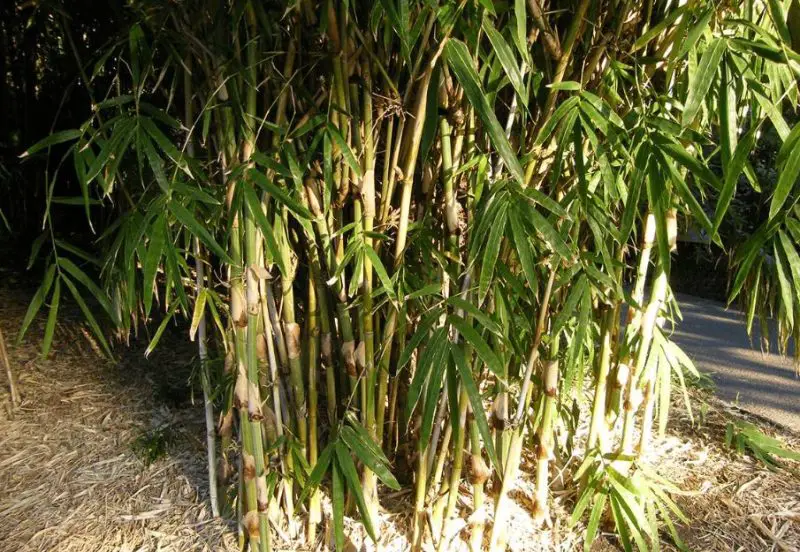
Bambusa multiplex, commonly called Hedge Bamboo, is a versatile clumping bamboo native to southern China. It is known for its dense, bushy growth habit and slender, tightly packed culms that create a lush, screen-like appearance. Hedge Bamboo typically grows between 10 to 30 feet (3 to 9 meters) tall, with culm diameters of about 1 inch (2.5 cm). The culms are green and smooth, bearing multiple branches at each node, which gives the plant its thick, leafy look.
This species grows best in USDA zones 8 to 11, preferring full sun to partial shade and moist, well-drained soils. It is relatively drought-tolerant once established and requires minimal maintenance apart from occasional pruning to shape and control its size. Hedge Bamboo is especially suitable for container planting, narrow spaces, and areas where a fast-growing, non-invasive screen is desired.
Bambusa multiplex is widely used for hedges, privacy screens, and ornamental landscaping in both residential and commercial settings. It is also favored for erosion control on slopes and embankments. Thanks to its elegant foliage, fast growth, and manageable size, Hedge Bamboo is a favorite choice for creating green walls, natural fences, and tropical garden accents.
Dendrocalamus asper (Sweet Bamboo)
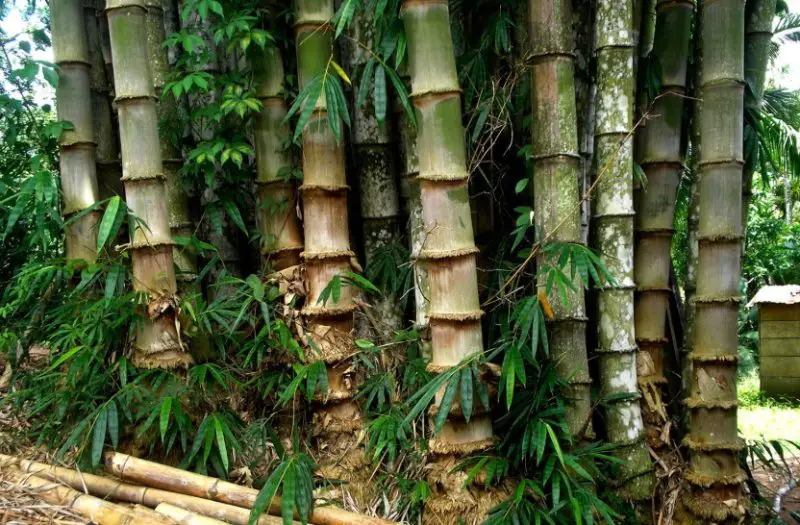
Dendrocalamus asper, commonly known as Sweet Bamboo, is a giant tropical bamboo native to Southeast Asia, particularly Indonesia, Thailand, and Malaysia. It features thick-walled, straight culms that can grow up to 65 to 100 feet (20 to 30 meters) tall, with diameters reaching 6 to 8 inches (15 to 20 cm). The culms are light green to grayish-green with a slightly rough surface, and the nodes are prominently ringed, making it easy to distinguish.
Sweet Bamboo grows well in USDA zones 10 to 11, preferring tropical and subtropical climates with abundant rainfall and rich, well-drained soils. It requires full sun exposure for best growth and benefits from consistent watering, particularly during dry periods. Due to its large size, it is best suited for spacious landscapes, and regular thinning is recommended to maintain healthy, vigorous clumps.
Highly valued for its edible shoots, which are tender and sweet, Dendrocalamus asper is a vital food source in many Southeast Asian cuisines. Its strong culms are used in construction, scaffolding, and handicrafts. With its towering size and elegant form, Sweet Bamboo is also planted for large-scale privacy screens, windbreaks, and as a striking centerpiece in tropical gardens.
Guadua angustifolia (South American Giant Bamboo)
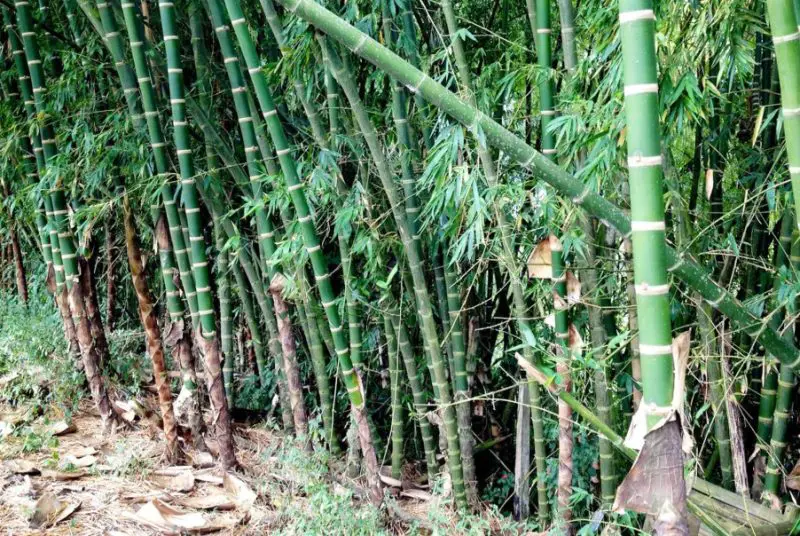
Guadua angustifolia, known as South American Giant Bamboo, is a massive, fast-growing bamboo species native to Colombia, Ecuador, and Venezuela. It is one of the strongest and most structurally significant bamboos in the world. The culms are thick, straight, and pale green to dark green, growing up to 98 feet (30 meters) tall and 5 to 6 inches (12 to 15 cm) in diameter. The nodes are very prominent and reinforced, contributing to its incredible strength.
This bamboo thrives in USDA zones 9 to 11, preferring warm, humid environments with well-drained, fertile soils. It grows best in full sun and requires regular watering, especially during the dry season. In landscape settings, it should be provided with ample space due to its large size and spreading growth habit. Maintenance involves removing old or dead culms to keep the clump healthy and productive.
Guadua angustifolia is extensively used for building houses, bridges, furniture, and artisanal crafts throughout South America. Its strength rivals that of steel, making it an essential material in sustainable architecture. In addition to its practical applications, its striking appearance and towering form make it a dramatic addition to large gardens, eco-resorts, and botanical collections.
Dendrocalamus giganteus (Giant Bamboo)

Dendrocalamus giganteus, aptly named Giant Bamboo, is among the tallest bamboo species in the world. Native to Southeast Asia, particularly Myanmar, Thailand, and India, it features enormous culms that can grow between 85 to 100 feet (26 to 30 meters) tall, with diameters of up to 12 inches (30 cm). The culms are light green with a smooth surface and slightly arching tips, creating a grand, sweeping silhouette.
Giant Bamboo flourishes in USDA zones 9 to 11, preferring hot, humid climates and fertile, well-drained soils. It requires full sun for optimal growth and consistent watering during its active growing season. Due to its sheer size, it needs a spacious planting site and benefits from occasional thinning of older culms to encourage robust new shoots.
Highly prized for construction, scaffolding, and heavy-duty crafts, Dendrocalamus giganteus is a cornerstone material in many Asian countries. Its towering, majestic presence also makes it a stunning focal point in parks, arboretums, and large private gardens. Beyond its practical uses, the impressive beauty of Giant Bamboo embodies strength, resilience, and the power of nature.
Fargesia nitida (Blue Fountain Bamboo)
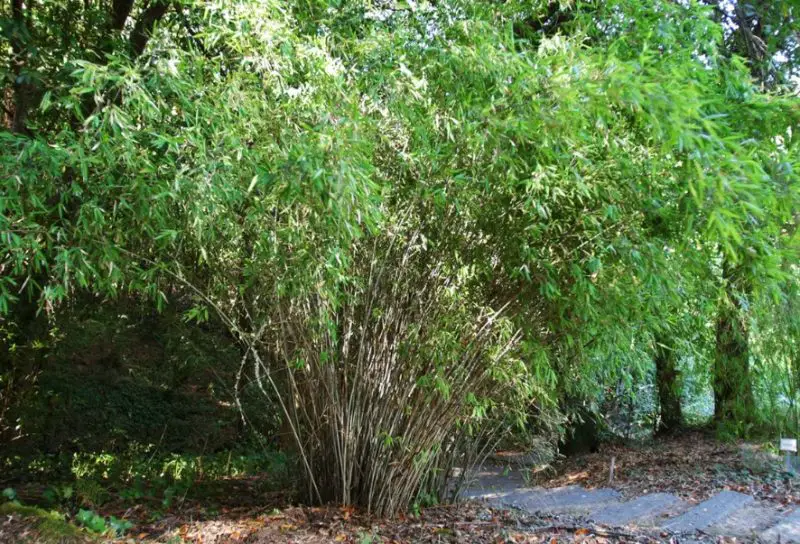
Fargesia nitida, commonly known as Blue Fountain Bamboo, is a cold-hardy clumping bamboo native to the mountainous regions of western China. It is admired for its slender, arching canes that emerge with a striking purplish-blue hue, contrasting beautifully with its small, delicate green leaves. Mature plants typically reach heights of 10 to 15 feet (3 to 4.5 meters) and have culms around 0.5 to 1 inch (1.3 to 2.5 cm) thick, creating an elegant, fountain-like silhouette.
This bamboo grows best in USDA zones 5 to 9, thriving in part shade with consistent moisture and well-drained, fertile soil. It can tolerate full sun in cooler climates but may need protection from harsh afternoon rays in hotter areas. Regular watering, mulching to retain moisture, and occasional thinning of older culms will ensure optimal growth and appearance.
Blue Fountain Bamboo is an excellent choice for shaded gardens, privacy screens, and container planting where a soft, flowing aesthetic is desired. Its non-invasive clumping habit and graceful form make it perfect for smaller landscapes and woodland settings. Its vibrant culm color and cold tolerance have made it one of the most popular ornamental bamboos for temperate gardens.
Otatea acuminata (Mexican Weeping Bamboo)
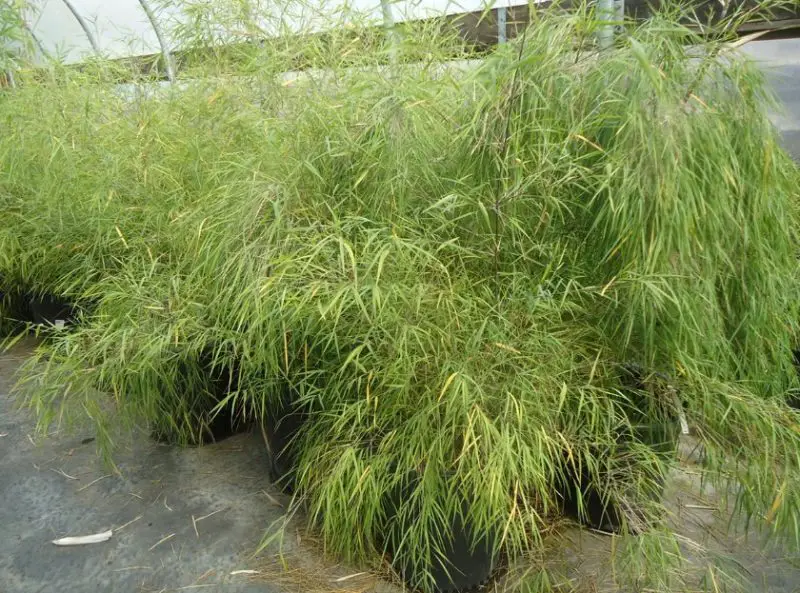
Otatea acuminata, often called Mexican Weeping Bamboo, is a graceful, drought-tolerant bamboo species native to Mexico. It is easily recognized by its narrow, arching leaves that create a soft, cascading appearance, giving the entire plant a weeping effect. Mature plants can grow up to 20 to 25 feet (6 to 7.5 meters) tall with slender culms about 1 to 1.5 inches (2.5 to 3.8 cm) in diameter, often appearing light green to bluish-green.
Thriving in USDA zones 8 to 10, Mexican Weeping Bamboo prefers full sun to light shade and well-drained soils. It is highly drought-tolerant once established but benefits from occasional deep watering during extended dry periods. Minimal maintenance is needed, apart from pruning to shape and removing older, less vigorous canes.
Otatea acuminata is widely used in xeriscaping, tropical-themed gardens, and as a specimen plant for its unique, flowing form. It also serves as an excellent privacy screen or windbreak in arid climates. Its elegant weeping habit and tough nature make it a valuable and attractive choice for landscape architects and gardeners seeking a graceful, low-water bamboo.
Bambusa textilis (Weaver’s Bamboo)
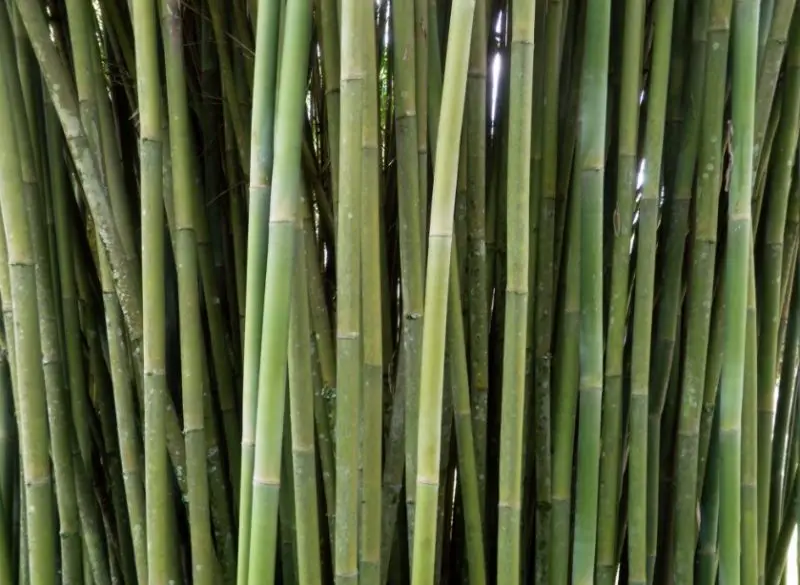
Bambusa textilis, commonly known as Weaver’s Bamboo, is a tall, elegant clumping bamboo native to southern China. It features straight, upright culms with a pale blue-green to yellow-green color, reaching heights of 30 to 40 feet (9 to 12 meters) and diameters of 1.5 to 2 inches (3.8 to 5 cm). Its tight, vertical growth and fine, dense foliage give it a polished, refined look.
Best suited for USDA zones 8 to 11, Weaver’s Bamboo prefers full sun to partial shade and thrives in well-drained, fertile soils. It requires regular watering during the growing season but can tolerate short periods of drought once established. Pruning of the lower branches enhances its elegant, tree-like appearance, making it even more attractive for landscaping.
Bambusa textilis is popular for creating tall, narrow privacy screens, windbreaks, and living walls. Its strong, straight canes have been traditionally used for weaving mats, baskets, and other crafts, hence the common name. Its combination of beauty, strength, and vertical growth habit makes it a versatile and highly desirable bamboo for both ornamental and practical uses.
Phyllostachys vivax (Chinese Timber Bamboo)
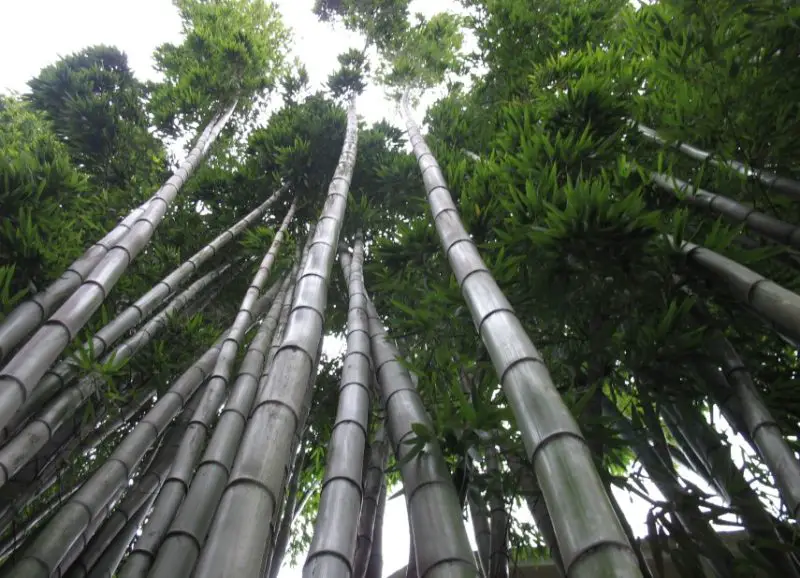
Phyllostachys vivax, known as Chinese Timber Bamboo, is a towering running bamboo species native to China. It boasts thick, strong culms that are bright green when young and mature to a golden-green shade, often reaching heights of 50 to 70 feet (15 to 21 meters) with diameters up to 5 inches (12.7 cm). Its large size and rapid growth make it one of the most impressive bamboo species available.
Chinese Timber Bamboo grows best in USDA zones 6 to 10, thriving in full sun and fertile, well-drained soils. It requires regular watering, especially during dry spells, and can spread vigorously without containment, so root barriers or dedicated bamboo groves are recommended. Periodic thinning of older culms helps maintain a healthy, attractive stand.
Phyllostachys vivax is widely used for large privacy screens, shade structures, and timber production. Its thick, strong culms are prized for building and crafting purposes. In landscapes, its massive presence and vibrant color provide a dramatic, tropical atmosphere, making it a popular choice for creating bold, architectural garden statements.
Phyllostachys bissetii (Bisset’s Bamboo)
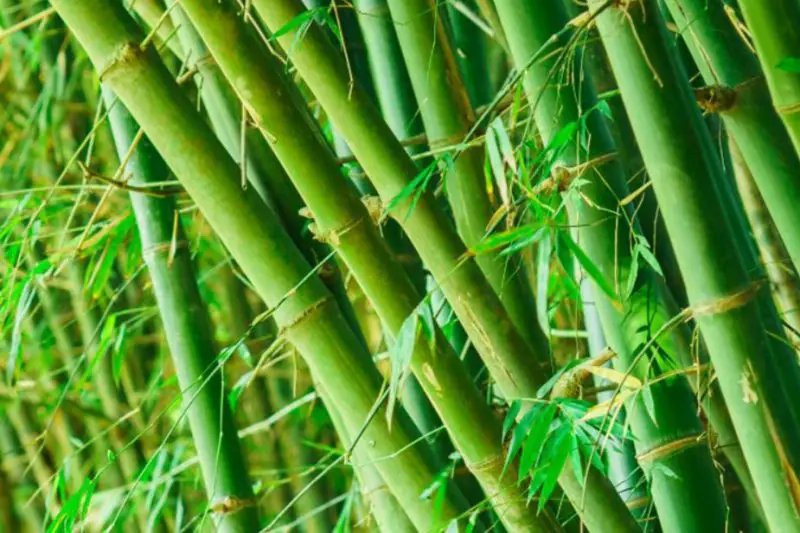
Phyllostachys bissetii, commonly known as Bisset’s Bamboo, is a cold-hardy running bamboo native to China. It is known for its dense, upright growth habit and dark green culms that remain attractive even through winter. Mature plants typically reach 15 to 20 feet (4.5 to 6 meters) tall with culm diameters of about 1 to 1.5 inches (2.5 to 3.8 cm).
This bamboo is best suited for USDA zones 5 to 10, making it one of the most reliable bamboos for colder climates. It thrives in full sun to partial shade and prefers moist, well-drained soils. It is fast-growing and resilient, requiring only occasional pruning and the use of barriers if spread control is desired.
Bisset’s Bamboo is an excellent choice for creating quick privacy screens, hedges, or windbreaks. Its hardy nature, attractive foliage, and fast growth have made it a favorite among gardeners looking for a low-maintenance, evergreen bamboo. In addition, its ability to withstand cold winds and frost adds to its value in temperate landscapes.
Semiarundinaria fastuosa (Narihira Bamboo)
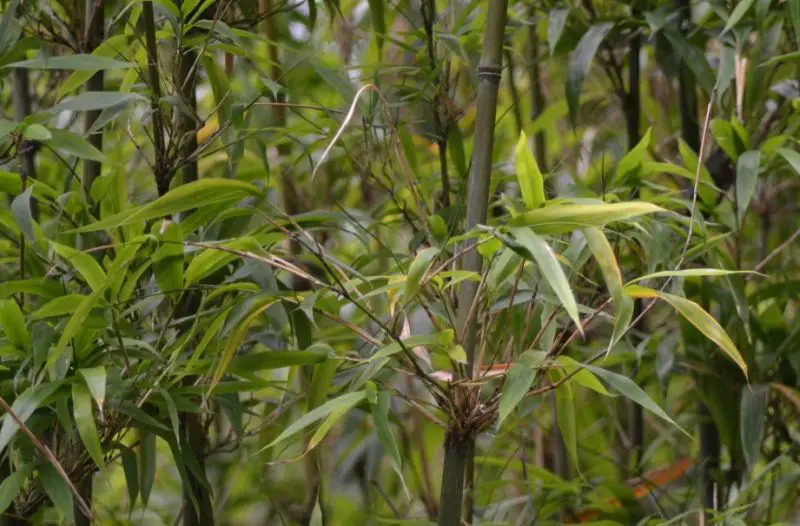
Semiarundinaria fastuosa, commonly known as Narihira Bamboo, is a beautiful, upright bamboo species native to Japan. It is admired for its straight, elegant culms that are deep green and can reach impressive heights of 20 to 30 feet (6 to 9 meters) with culm diameters around 1 to 2 inches (2.5 to 5 cm). The narrow, vertical form and neatly arranged foliage give it a formal, architectural look.
Narihira Bamboo thrives in USDA zones 7 to 10, preferring full sun to partial shade and moist, fertile soils. It grows moderately fast and benefits from regular watering during dry periods. Minimal maintenance is needed beyond occasional thinning of older canes to maintain its tidy appearance and encourage new growth.
Semiarundinaria fastuosa is popular for use in creating tall, elegant screens, formal hedges, and striking vertical accents in gardens. Its neat, upright habit makes it ideal for smaller spaces where a towering but narrow bamboo is desired. With its rich green culms and refined structure, Narihira Bamboo brings a sense of order and beauty to both traditional and contemporary landscapes.
Thyrsostachys siamensis (Monastery Bamboo)
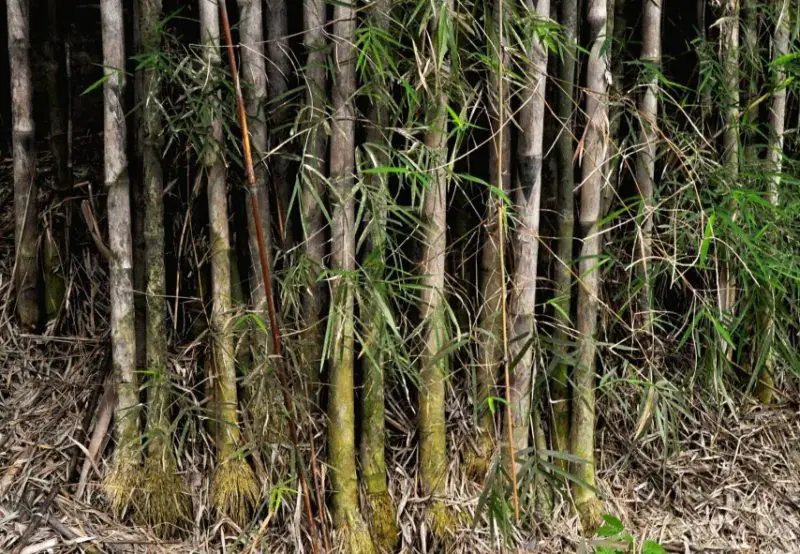
Thyrsostachys siamensis, commonly known as Monastery Bamboo, originates from Southeast Asia, particularly Thailand and Myanmar. It is a tight-clumping bamboo with stiff, upright culms that are bright green, sometimes aging to a golden-yellow color. Mature plants usually grow to heights of 20 to 30 feet (6 to 9 meters) with culm diameters around 1 to 1.5 inches (2.5 to 3.8 cm), forming dense, columnar groves.
Monastery Bamboo thrives in USDA zones 9 to 11, preferring full sun and rich, well-drained soils. It is notably drought-tolerant once established but benefits from regular watering during dry spells. Minimal maintenance is needed beyond occasional removal of older culms and providing ample space for its clump to expand naturally.
This species is popular for ornamental plantings, dense privacy screens, and windbreaks. Its upright, non-invasive growth habit makes it especially useful in smaller gardens where space is limited. Monastery Bamboo’s strong, straight culms have also been traditionally used in Southeast Asia for construction and scaffolding purposes.
Pleioblastus pygmaeus (Pygmy Bamboo)
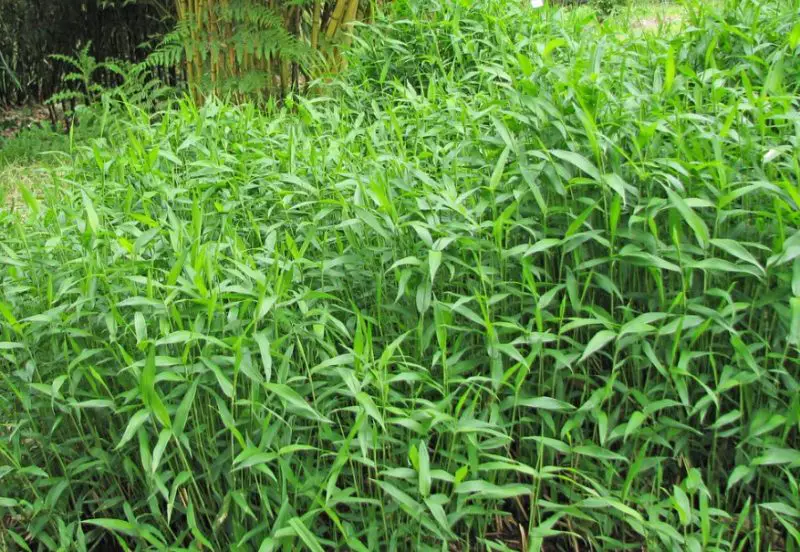
Pleioblastus pygmaeus, often referred to as Pygmy Bamboo, is a dwarf bamboo species native to Japan. It features low, spreading growth with small, narrow leaves and thin culms, usually reaching only 1 to 2 feet (30 to 60 cm) tall. Its fine-textured, dense foliage makes it appear almost like a ground cover rather than a traditional bamboo.
This bamboo performs best in USDA zones 6 to 9, thriving in partial to full sun and preferring moist, well-drained soils. It is very hardy and can handle a wide range of conditions, although regular watering during dry periods will keep it lush. Pygmy Bamboo responds well to trimming, allowing gardeners to maintain a neat, carpet-like effect.
Pleioblastus pygmaeus is often used for ground covers, erosion control, and underplanting in Japanese-style gardens. Its dense mat of foliage provides excellent weed suppression, and it can also be grown in containers or used as a low hedge. In colder areas, its top growth may die back in winter but will quickly regenerate in spring.
Chusquea culeou (Chilean Bamboo)
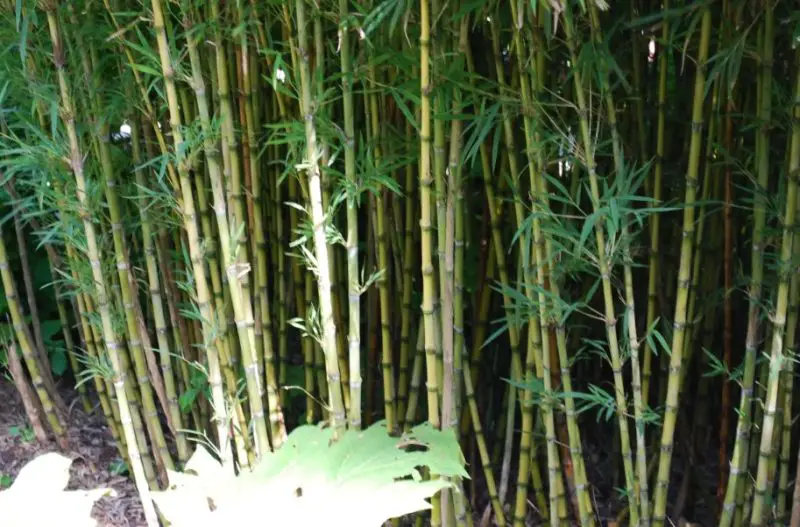
Chusquea culeou, commonly called Chilean Bamboo, is native to the temperate forests of southern Chile and Argentina. Unlike most bamboos, it has solid, rather than hollow, culms that are typically deep green and grow in an upright, arching form. Mature plants can reach heights of 15 to 20 feet (4.5 to 6 meters) with culm diameters around 1 inch (2.5 cm).
Chilean Bamboo thrives in USDA zones 7 to 10, preferring full sun to partial shade and moist, well-drained soils. It is notably cold-hardy and tolerates occasional frosts better than many other bamboos. Regular watering and occasional thinning of older culms will help maintain a healthy, attractive stand.
Chusquea culeou is a great choice for informal screens, hedges, and ornamental plantings where a softer, natural look is desired. Its unique solid culms make it valuable for specialty crafts and woodworking. Its lush, evergreen foliage and ability to handle cooler climates make it a prized specimen in temperate gardens.
Drepanostachyum falcatum (Himalayan Weeping Bamboo)
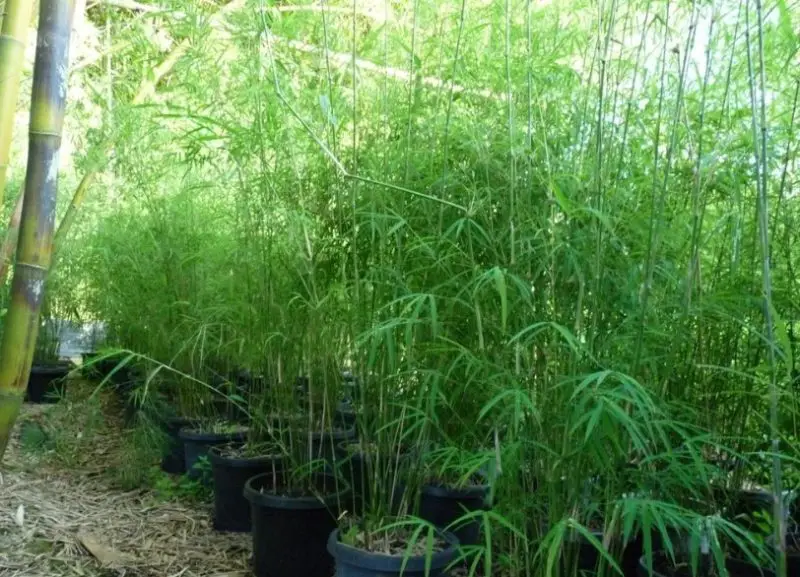
Drepanostachyum falcatum, known as Himalayan Weeping Bamboo, is a graceful bamboo species native to the mountainous regions of the Himalayas. It features slender, arching culms with drooping, narrow leaves that create a weeping effect. Plants typically reach heights of 15 to 20 feet (4.5 to 6 meters) and have culms about 1 inch (2.5 cm) in diameter.
Himalayan Weeping Bamboo grows best in USDA zones 7 to 10, thriving in partial shade and moist, well-drained soils rich in organic matter. It appreciates regular watering, especially during hot, dry periods. Light pruning helps to maintain its elegant form and encourage new growth.
Drepanostachyum falcatum is a beautiful choice for adding movement and softness to shaded gardens, woodland settings, or water features. Its graceful, arching foliage adds a tranquil, flowing quality to any landscape. Gardeners value it for its beauty, non-invasive clumping habit, and adaptability to cooler mountain climates.
Indocalamus tessellatus (Giant Leaf Bamboo)
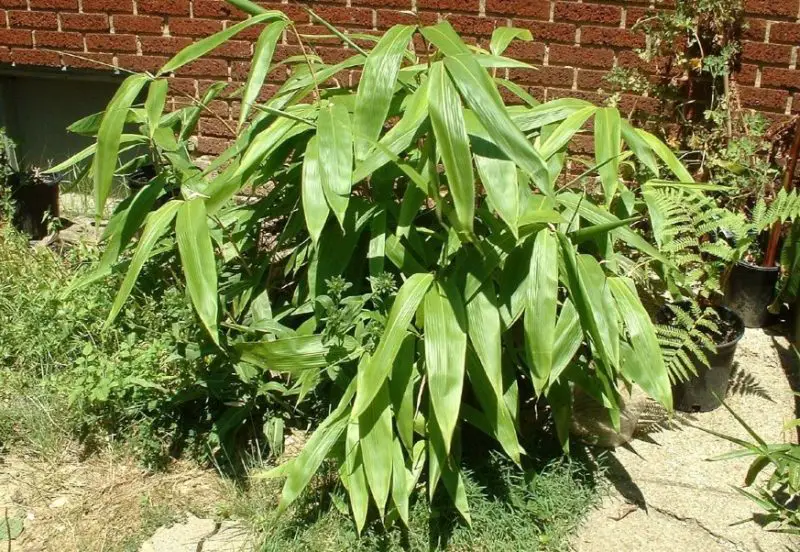
Indocalamus tessellatus, commonly known as Giant Leaf Bamboo, is a broad-leaved bamboo species native to southern China. It is best known for its enormous leaves, which can grow up to 24 inches (60 cm) long and 4 inches (10 cm) wide, creating a lush, tropical appearance. Plants generally reach heights of 6 to 10 feet (1.8 to 3 meters) with slender culms.
This species thrives in USDA zones 6 to 9, preferring partial to full shade and moist, well-drained soils. It requires regular watering to maintain its lush foliage, especially in drier climates. Pruning back older canes and thinning dense growth will keep it looking its best.
Indocalamus tessellatus is a popular choice for creating bold textures in shaded gardens, underplantings, or even large containers. Its massive leaves add a striking, exotic feel to temperate gardens. It is also a great option for erosion control on slopes, where its spreading habit can help stabilize the soil.
Yushania anceps (Hardy Himalayan Bamboo)
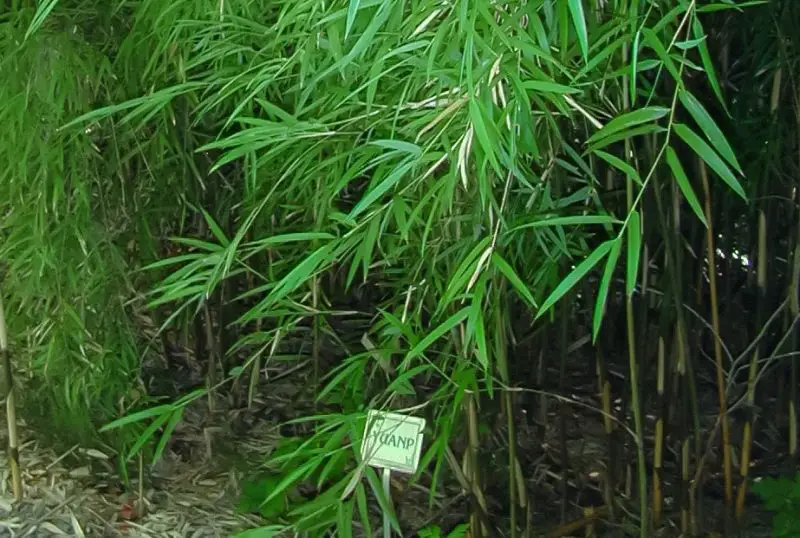
Yushania anceps, often called Hardy Himalayan Bamboo, is native to the high altitudes of the Himalayas. It forms a loose clump with thin, arching culms that are deep green and flexible. Mature plants typically grow 10 to 15 feet (3 to 4.5 meters) tall with culms about 0.5 to 1 inch (1.3 to 2.5 cm) thick, creating a delicate, airy appearance.
This bamboo is suited for USDA zones 6 to 9, thriving in partial shade and well-drained, humus-rich soils. It appreciates regular moisture but is tolerant of short dry spells once established. Minimal maintenance is needed beyond the occasional removal of old or damaged culms.
Yushania anceps is ideal for naturalistic plantings, woodland gardens, and informal hedges. Its ability to thrive in cooler, mountainous regions makes it a valuable bamboo for temperate landscapes. Gardeners appreciate its soft, flowing form and reliable cold hardiness compared to other clumping bamboos.
Chimonobambusa tumidissinoda (Walking Stick Bamboo)

Chimonobambusa tumidissinoda, known as Walking Stick Bamboo, is native to Sichuan province in China. It is highly distinctive for its swollen, knobby nodes, giving the culms a bumpy appearance that has historically made it popular for crafting ornate walking sticks. Mature plants typically reach heights of 10 to 20 feet (3 to 6 meters) and feature dark green culms about 1 to 1.5 inches (2.5 to 3.8 cm) thick.
Walking Stick Bamboo thrives in USDA zones 7 to 10, preferring partial shade to full shade and moist, rich, well-drained soils. It benefits from consistent watering, especially during dry periods, and appreciates protection from harsh afternoon sun in hotter climates. Occasional thinning of older culms keeps the grove vigorous and attractive.
This bamboo is prized for ornamental plantings, unique crafts, and historical garden designs. Its unusual appearance and graceful, arching foliage make it a standout specimen. Walking Stick Bamboo’s solid and durable culms continue to be sought after for artisanal projects and decorative garden features.
Gigantochloa atroviolacea (Black Tropical Bamboo)
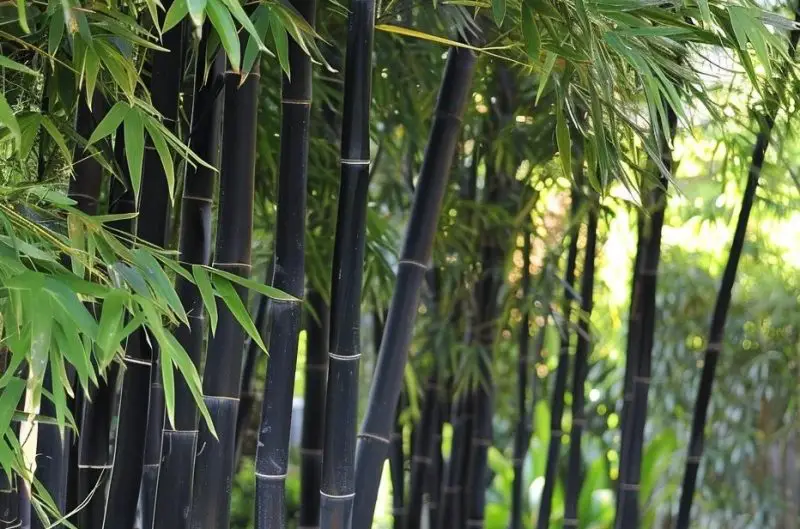
Gigantochloa atroviolacea, commonly called Black Tropical Bamboo, hails from Southeast Asia, particularly Indonesia. This spectacular bamboo features dark purplish-black culms that can reach heights of 30 to 50 feet (9 to 15 meters), with thick stems up to 4 inches (10 cm) in diameter. Its upright growth and glossy, lush foliage give it an exceptionally tropical and dramatic appearance.
This bamboo is suited for USDA zones 10 to 11, thriving in full sun and warm, humid environments with rich, well-drained soils. Regular watering, especially during dry spells, ensures robust growth. Gigantochloa atroviolacea also benefits from annual fertilization and light pruning to remove older, less attractive culms.
Black Tropical Bamboo is highly valued for decorative landscaping, privacy screens, and architectural focal points. Its striking black culms are also traditionally used in Southeast Asia for furniture-making and construction. Gardeners appreciate its rapid growth and stunning contrast against lighter green foliage.
Bambusa lako (Timor Black Bamboo)
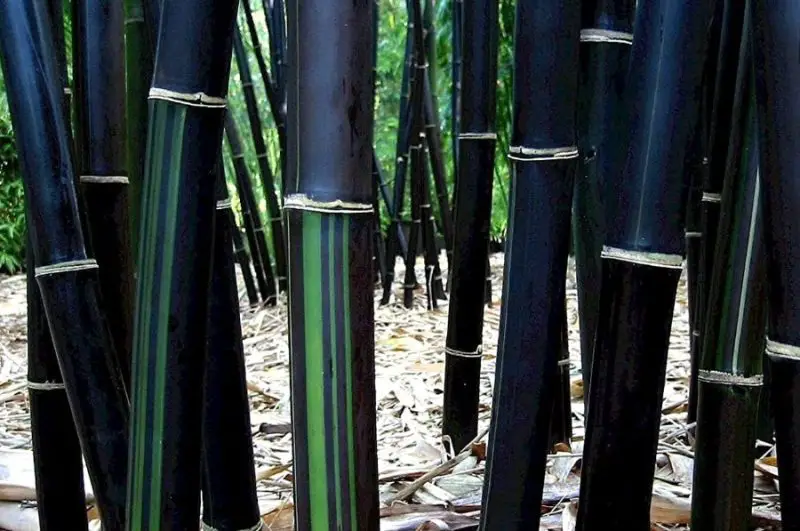
Bambusa lako, known as Timor Black Bamboo, originates from the island of Timor in Indonesia. It is one of the most striking bamboos, with smooth, glossy black culms that can reach up to 40 to 50 feet (12 to 15 meters) tall and about 4 inches (10 cm) thick. New shoots emerge green before maturing to deep black, creating a beautiful transition of color.
Timor Black Bamboo grows well in USDA zones 9 to 11, thriving in full sun and rich, well-drained soils with regular watering. It prefers a warm, humid climate and benefits from protection against cold winds. Regular feeding and the removal of older culms help maintain its health and striking appearance.
Highly prized for its ornamental value, Bambusa lako is often used in luxury landscaping, large privacy screens, and tropical gardens. Its strong, straight black culms also find use in fine woodworking and artisan crafts. Gardeners favor it for its non-invasive, clumping growth habit and breathtaking visual impact.
Pleioblastus viridistriatus (Dwarf Green-Striped Bamboo)
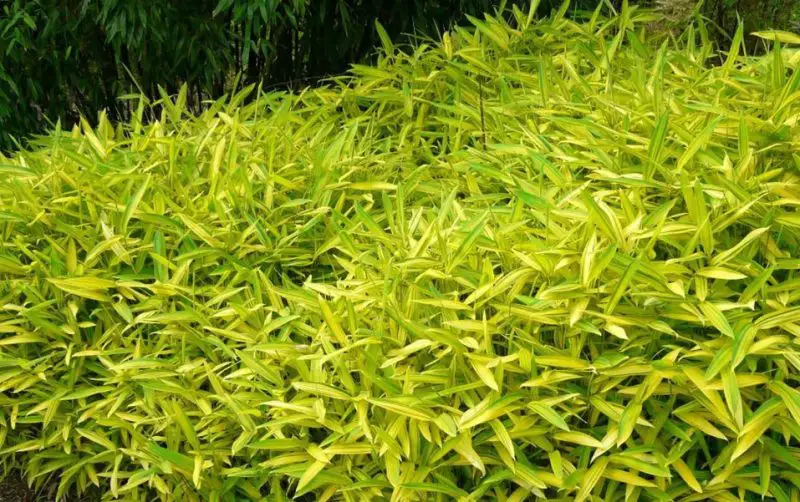
Pleioblastus viridistriatus, often called Dwarf Green-Striped Bamboo, is a colorful, low-growing bamboo native to Japan. It is celebrated for its bright green leaves streaked with golden yellow stripes, creating a vivid display throughout the growing season. Mature plants usually reach only 2 to 4 feet (0.6 to 1.2 meters) tall, spreading rapidly to form dense ground covers.
This bamboo thrives in USDA zones 6 to 9, preferring partial shade to full sun and moist, fertile, well-drained soils. It needs regular watering to keep its vibrant foliage healthy, especially in hot, dry periods. In colder climates, the foliage may die back in winter but quickly rejuvenates in spring.
Pleioblastus viridistriatus is widely used as ground cover, border edging, or container plantings for splashy, colorful displays. It is valued for its fast spread and ability to brighten shady areas. Gardeners often cut it back in early spring to refresh the foliage and encourage vigorous new growth.
Sasa veitchii (Kuma Bamboo Grass)
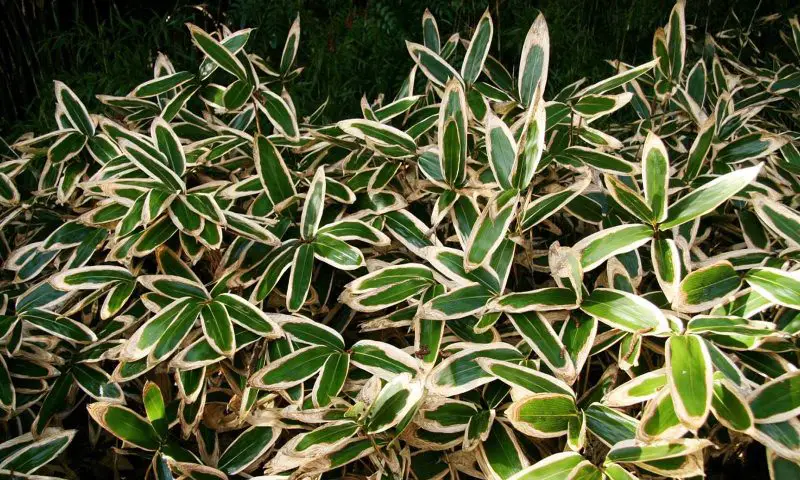
Sasa veitchii, known as Kuma Bamboo Grass, is a broad-leaved bamboo native to Japan. Its lush green leaves develop striking white-edged margins as they age into fall and winter, creating a unique variegated appearance. It typically grows 2 to 5 feet (0.6 to 1.5 meters) tall, spreading widely via underground rhizomes.
This hardy bamboo thrives in USDA zones 5 to 9, preferring partial to full shade and moist, well-drained soils. Sasa veitchii requires regular watering to maintain its dense, healthy foliage and can benefit from trimming to control its spread. In colder regions, it may experience some winter dieback, followed by vigorous regrowth.
Kuma Bamboo Grass is popular for ground cover, erosion control, and woodland gardens where a naturalized look is desired. Its distinctive winter leaf coloration adds year-round interest. Gardeners appreciate its resilience, ability to colonize slopes, and adaptability to a variety of soil conditions.
Shibataea kumasaca (Ruscus-leaf Bamboo)
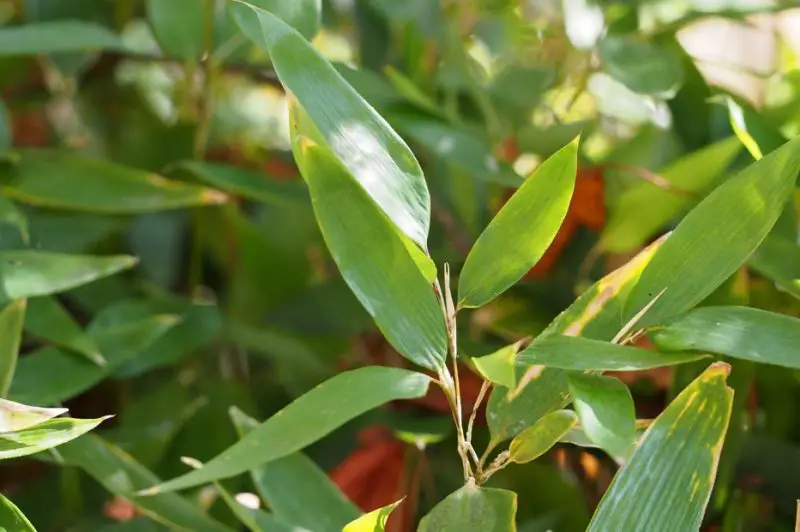
Shibataea kumasaca, commonly referred to as Ruscus-leaf Bamboo, is a compact bamboo species native to southern China. It features short, rounded, dark green leaves that resemble those of a Ruscus plant, and dense, upright culms that grow to about 3 to 5 feet (0.9 to 1.5 meters) tall.
This species grows best in USDA zones 6 to 9, preferring partial shade and consistently moist, well-drained soils. It appreciates protection from intense afternoon sun, which can scorch its attractive foliage. Occasional thinning and trimming help maintain a neat, upright form.
Ruscus-leaf Bamboo is favored for low hedges, screens, and container gardening. Its dense, bushy growth habit and evergreen leaves provide year-round beauty. Gardeners often use it in Asian-style gardens, formal landscapes, or as an elegant backdrop for flowering perennials.
Phyllostachys heteroclada (Water Bamboo)
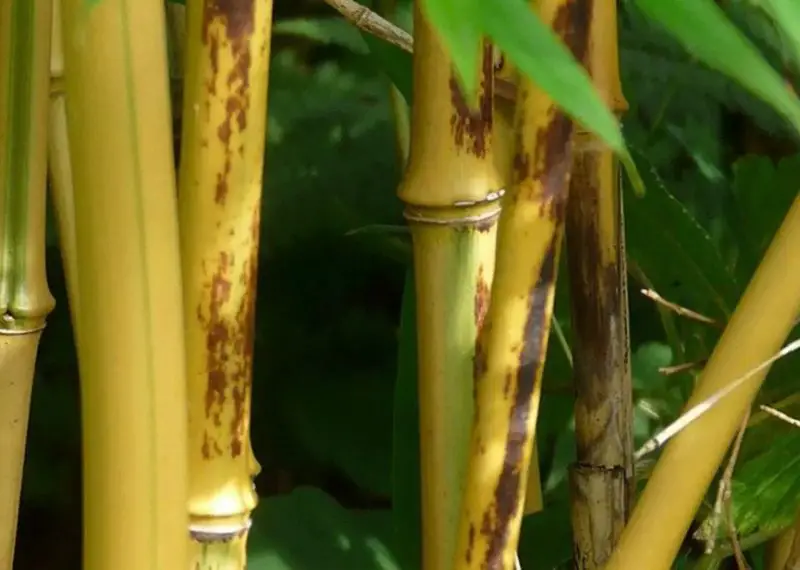
Phyllostachys heteroclada, commonly known as Water Bamboo, originates from China and is notable for its ability to thrive in wet, boggy soils. It features sturdy, upright culms with a bluish-green hue and distinctive air canals in the lower nodes, allowing it to survive periodic flooding. Mature plants can reach heights of 30 to 40 feet (9 to 12 meters) with culms about 2 inches (5 cm) in diameter.
Water Bamboo grows well in USDA zones 6 to 10, flourishing in full sun to partial shade and favoring moist, well-drained to wet soils. It appreciates regular watering and can even grow in shallow standing water, making it ideal for rain gardens and pond edges. Occasional thinning of older culms encourages vigorous, healthy growth.
This bamboo is valued for erosion control, water garden landscapes, and natural privacy screens. Its graceful, upright form and tolerance for soggy soils make it a unique choice for challenging sites. Gardeners also admire its fast growth and adaptability to a range of conditions.
Arundinaria gigantea (Giant Cane)
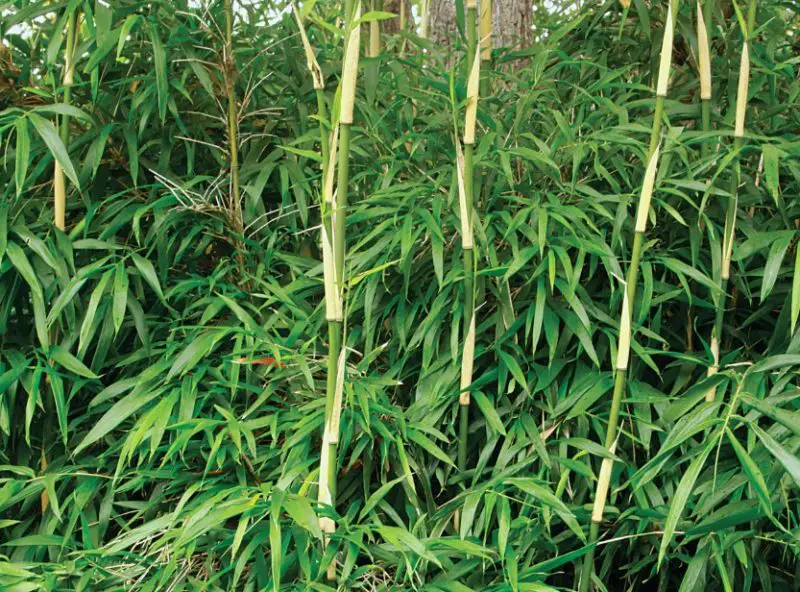
Arundinaria gigantea, known as Giant Cane, is native to the southeastern United States and is one of the only bamboos indigenous to North America. It produces tall, woody culms that can grow 20 to 30 feet (6 to 9 meters) high with stems about 1 inch (2.5 cm) thick. The leaves are long, narrow, and lush green, forming dense thickets called canebrakes.
Giant Cane thrives in USDA zones 5 to 9, preferring moist, fertile, and slightly acidic soils in partial shade to full sun. It requires regular watering, especially during establishment, and benefits from occasional thinning to prevent overcrowding. In colder regions, it may die back but often resprouts from the roots.
Historically significant, Arundinaria gigantea was used by Native Americans for weaving mats, baskets, and arrow shafts. Today, it is used for habitat restoration, erosion control, and creating naturalistic landscapes. Its ability to stabilize riverbanks and wetlands makes it a valuable ecological plant.
Chimonobambusa quadrangularis (Square-Stemmed Bamboo)
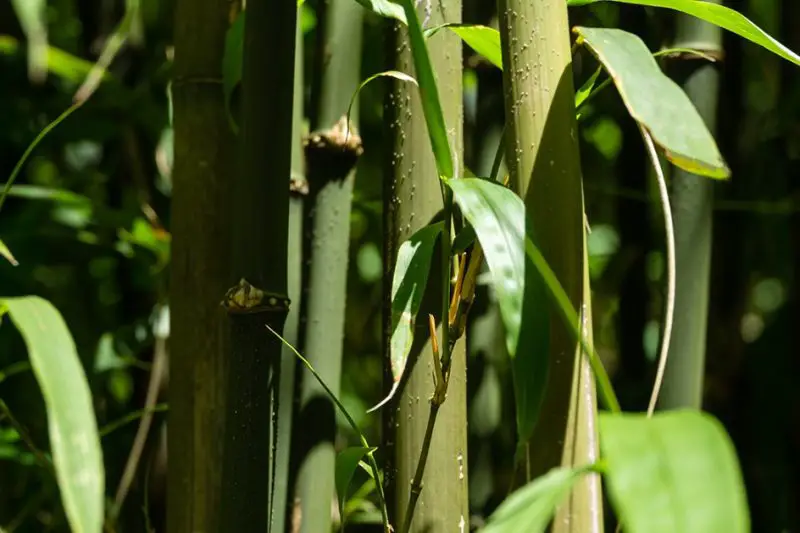
Chimonobambusa quadrangularis, or Square-Stemmed Bamboo, is a rare and fascinating bamboo species native to China. It is distinguished by its unique, almost square-shaped culms, which are light green and smooth. Mature plants grow to about 10 to 15 feet (3 to 4.5 meters) tall, with slim, elegant stems and lush foliage.
This bamboo is best suited to USDA zones 7 to 10, preferring partial shade and consistently moist, fertile soils. It appreciates protection from harsh winds and benefits from regular watering and mulching to retain soil moisture. Pruning dead or weak culms enhances its appearance and vitality.
Square-Stemmed Bamboo is a prized ornamental plant, often used in specialty gardens and Asian-themed landscapes. Its unusual stem shape adds architectural interest, making it a conversation piece. Gardeners value it for its manageable size, non-invasive growth habit, and exquisite, graceful beauty.
Neololeba atra (Black Bamboo of Papua)
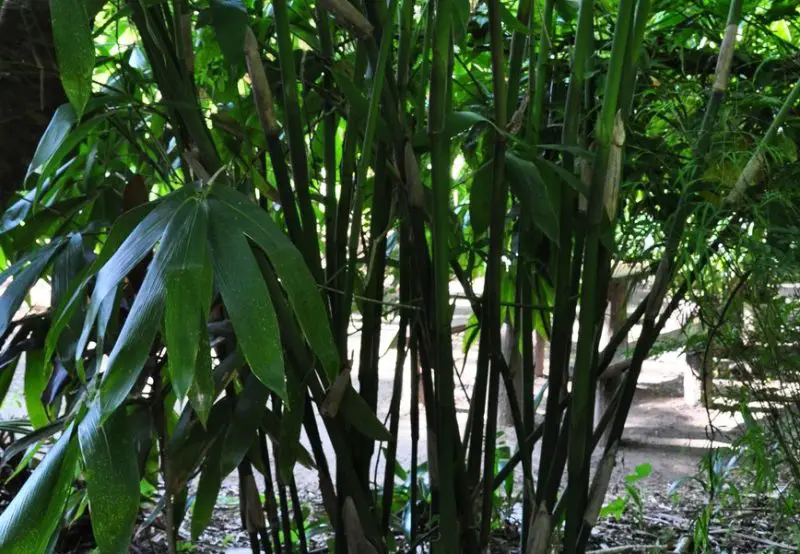
Neololeba atra, known as the Black Bamboo of Papua, is native to Papua New Guinea and surrounding tropical regions. It features tall, arching culms that range from dark green to nearly black with maturity. Plants can soar to heights of 50 to 65 feet (15 to 20 meters), creating dramatic, towering groves.
This tropical bamboo is ideal for USDA zones 10 to 11, thriving in hot, humid environments with rich, well-drained soils. It requires regular watering and high humidity for optimal growth and should be sheltered from cold or drying winds. Annual feeding with organic fertilizer helps maintain its vigor.
Black Bamboo of Papua is highly valued for its dramatic appearance, often used in large landscape designs, tropical gardens, and for creating bold backdrops. Its strong, flexible culms are also utilized in construction and crafts in its native regions. Gardeners love it for its rapid growth and striking tropical aesthetic.
Bambusa beecheyana (Beechey Bamboo)
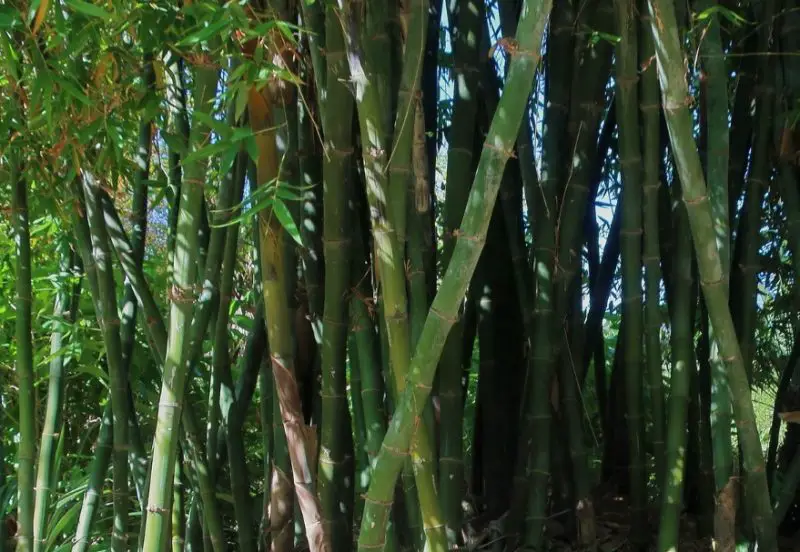
Bambusa beecheyana, commonly called Beechey Bamboo, originates from southern China and Vietnam. It is a medium to large clumping bamboo with light green culms that can grow up to 30 to 50 feet (9 to 15 meters) tall, with thick walls and a graceful, upright habit. The culms are often slightly curved, adding to its elegant form.
This bamboo thrives in USDA zones 9 to 11, preferring full sun to partial shade and fertile, well-drained soils. It requires consistent watering during dry spells and benefits from a balanced fertilizer applied in the growing season. Regular removal of old culms keeps the clump looking fresh and healthy.
Beechey Bamboo is popular for privacy screens, windbreaks, and ornamental plantings. Its fast growth and attractive form make it a versatile choice for both residential and commercial landscapes. Gardeners appreciate its non-invasive clumping habit, making it easier to manage than many running bamboos.
Oxytenanthera abyssinica (African Bamboo)
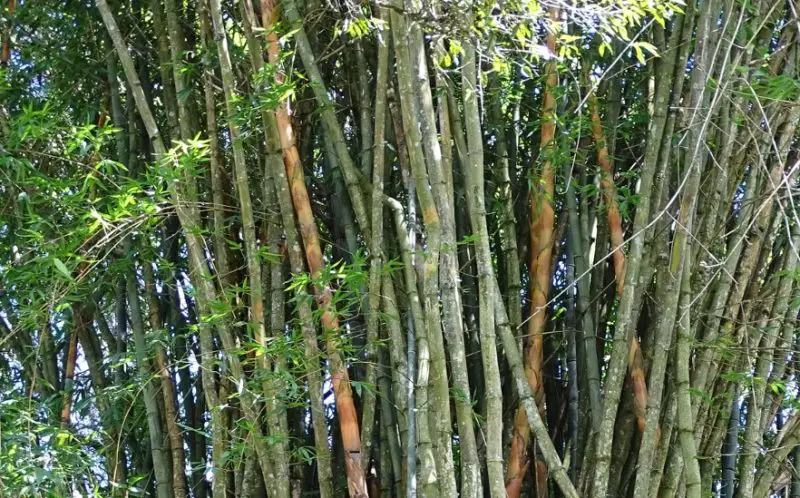
Oxytenanthera abyssinica, commonly called African Bamboo, is native to the tropical regions of Africa, particularly Ethiopia, Sudan, and Uganda. It forms dense clumps with tall, upright culms that are light green when young, maturing to a yellowish-green. This species can reach heights of 20 to 33 feet (6 to 10 meters) and features thick-walled, straight stems.
African Bamboo grows well in USDA zones 9 to 11, thriving in full sun and well-drained soils. It is drought-tolerant once established, making it an excellent choice for arid and semi-arid landscapes. Regular pruning of older culms encourages healthier growth and a neater appearance.
This bamboo is traditionally used in Africa for construction, furniture making, and weaving. Its strong, straight culms make it ideal for building materials and fencing. Gardeners appreciate it for its resilience, non-invasive clumping habit, and ability to thrive in hot, dry climates where other bamboos may struggle.
Bambusa boniopsis (Small Tropical Bamboo)
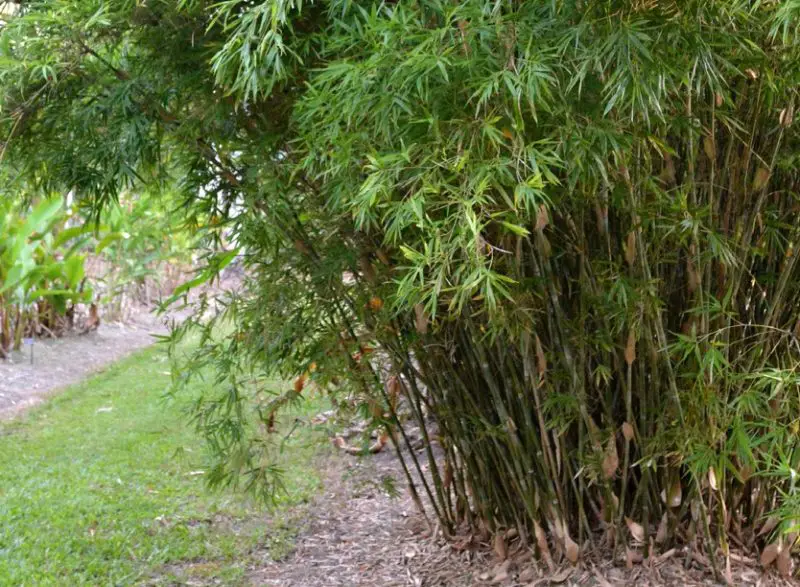
Bambusa boniopsis, known as Small Tropical Bamboo, is a compact species native to tropical regions of Asia. It features slender, gracefully arching culms with a rich green color and dense foliage. Typically, it grows to a modest height of 10 to 20 feet (3 to 6 meters), making it ideal for smaller spaces and ornamental gardens.
Small Tropical Bamboo thrives in USDA zones 9 to 11, preferring partial shade to full sun and moist, well-drained soils. It requires regular watering during dry periods and benefits from occasional feeding with a balanced fertilizer to maintain lush growth. Mulching helps conserve soil moisture and protect the roots.
Because of its manageable size and attractive appearance, Bambusa boniopsis is popular for hedges, container gardens, and tropical-themed landscapes. Its dense foliage provides excellent screening, and its delicate appearance adds a soft, elegant touch to any setting. It is especially favored in courtyards and compact gardens.
Dendrocalamus strictus (Male Bamboo)
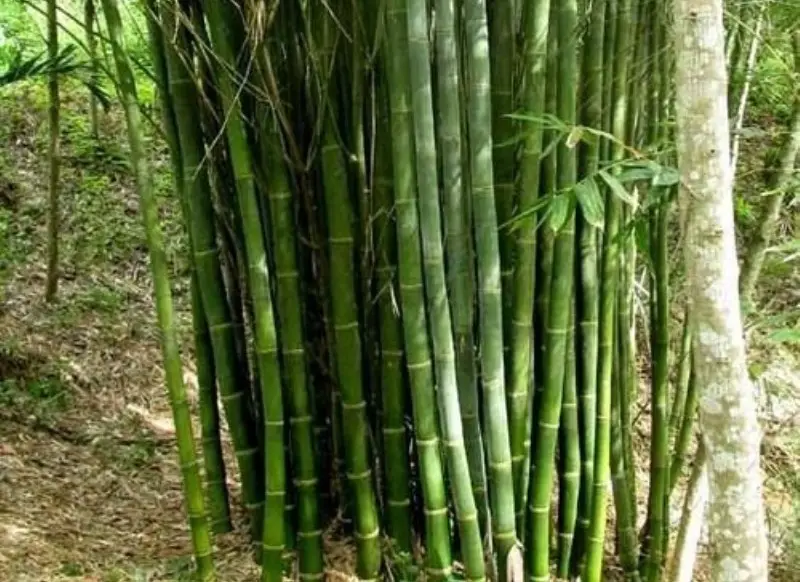
Dendrocalamus strictus, commonly known as Male Bamboo, is native to India, Nepal, and Southeast Asia. It features strong, thick-walled culms that range in color from dark green to grayish-green and often have a rough, dull texture. This bamboo can reach impressive heights of 30 to 60 feet (9 to 18 meters) with culms up to 4 inches (10 cm) in diameter.
Male Bamboo thrives in USDA zones 9 to 11, preferring full sun and well-drained, slightly dry soils. It is highly drought-tolerant once established and requires minimal watering, making it suitable for low-maintenance landscapes. Occasional thinning of old culms helps maintain the health and vigor of the clump.
This bamboo is widely used for construction, scaffolding, paper pulp, and furniture due to its strong, heavy culms. It is a favorite for erosion control projects and windbreaks as well. Gardeners value it for its robust nature, fast growth, and its ability to withstand tough environmental conditions.
Gigantochloa apus (Tali Bamboo)
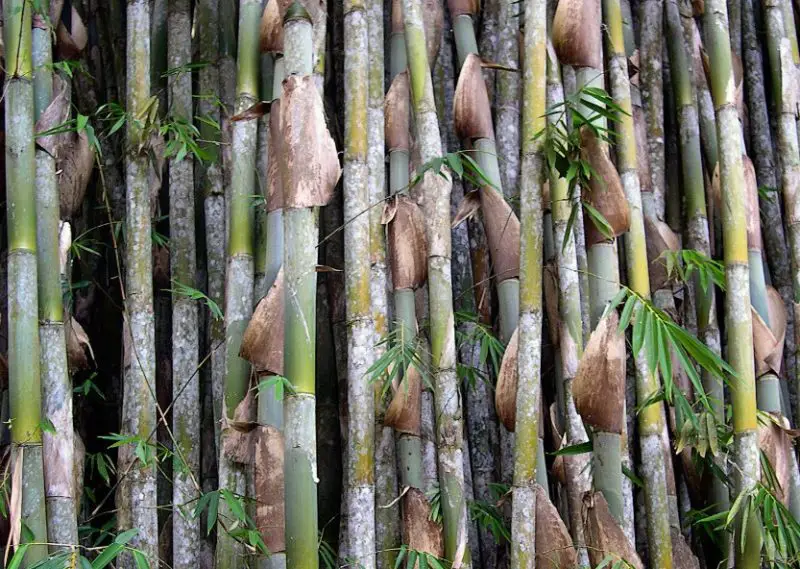
Gigantochloa apus, known as Tali Bamboo, is a tropical species native to Indonesia and Malaysia. It is characterized by tall, straight culms that are initially light green and mature to a soft yellowish-green with age. Mature plants typically reach 50 to 70 feet (15 to 21 meters) in height, creating impressive groves.
Tali Bamboo grows best in USDA zones 10 to 11, favoring warm, humid climates with rich, well-drained soils. It requires regular watering, especially during dry seasons, and benefits from organic mulch and fertilizer to sustain its rapid growth. Protecting it from strong winds will help maintain straight, healthy culms.
This bamboo is highly valued in its native regions for construction, handicrafts, and musical instruments. It is especially prized for making flutes and other traditional instruments. Gardeners admire Gigantochloa apus for its graceful, tall habit and its ability to create stunning vertical accents in tropical landscapes.
Bambusa chungii (Tropical Blue Bamboo)
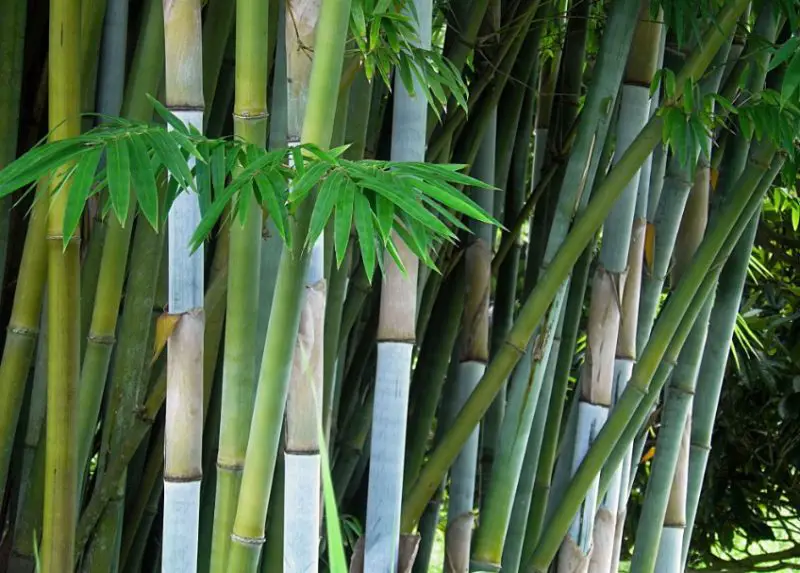
Bambusa chungii, commonly called Tropical Blue Bamboo, hails from southern China and Vietnam. It is known for its stunning powdery blue culms that stand out vividly against its green foliage. This elegant bamboo can grow up to 35 to 50 feet (10 to 15 meters) tall, forming dense, arching clumps.
Tropical Blue Bamboo thrives in USDA zones 9 to 11, preferring full sun to partial shade and fertile, well-drained soils. Regular watering and occasional feeding with a high-nitrogen fertilizer help maintain its vigorous growth. It benefits from mulching to conserve soil moisture and protect its roots.
Highly prized for ornamental landscaping, Bambusa chungii is often used as a centerpiece in tropical gardens, large containers, and luxury landscapes. Its unique blue coloration and graceful form make it a favorite among bamboo enthusiasts. It is also appreciated for its clumping, non-invasive habit, making maintenance much easier.


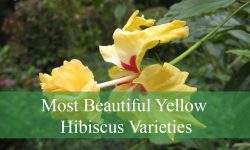

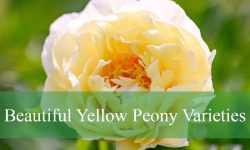
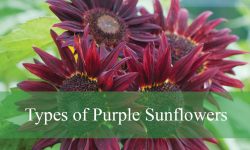

BEAUTIFUL, SEEDLINGS?, PRICE?